Automated Medical Store Management System
VerifiedAdded on 2021/03/01
|12
|3133
|50
AI Summary
The assignment discusses the concept of automating medical store management in hospitals, highlighting the benefits and drawbacks of such a system. It emphasizes the need for a comprehensive surveillance system, including clinics, hospitals, and pharmacies, as well as the importance of digital dispensing of medicines. The document also mentions the potential for a World Health Organization Medical Stores network and the importance of improving patient care and cost-cutting through an instant archive of medical knowledge.
Contribute Materials
Your contribution can guide someone’s learning journey. Share your
documents today.
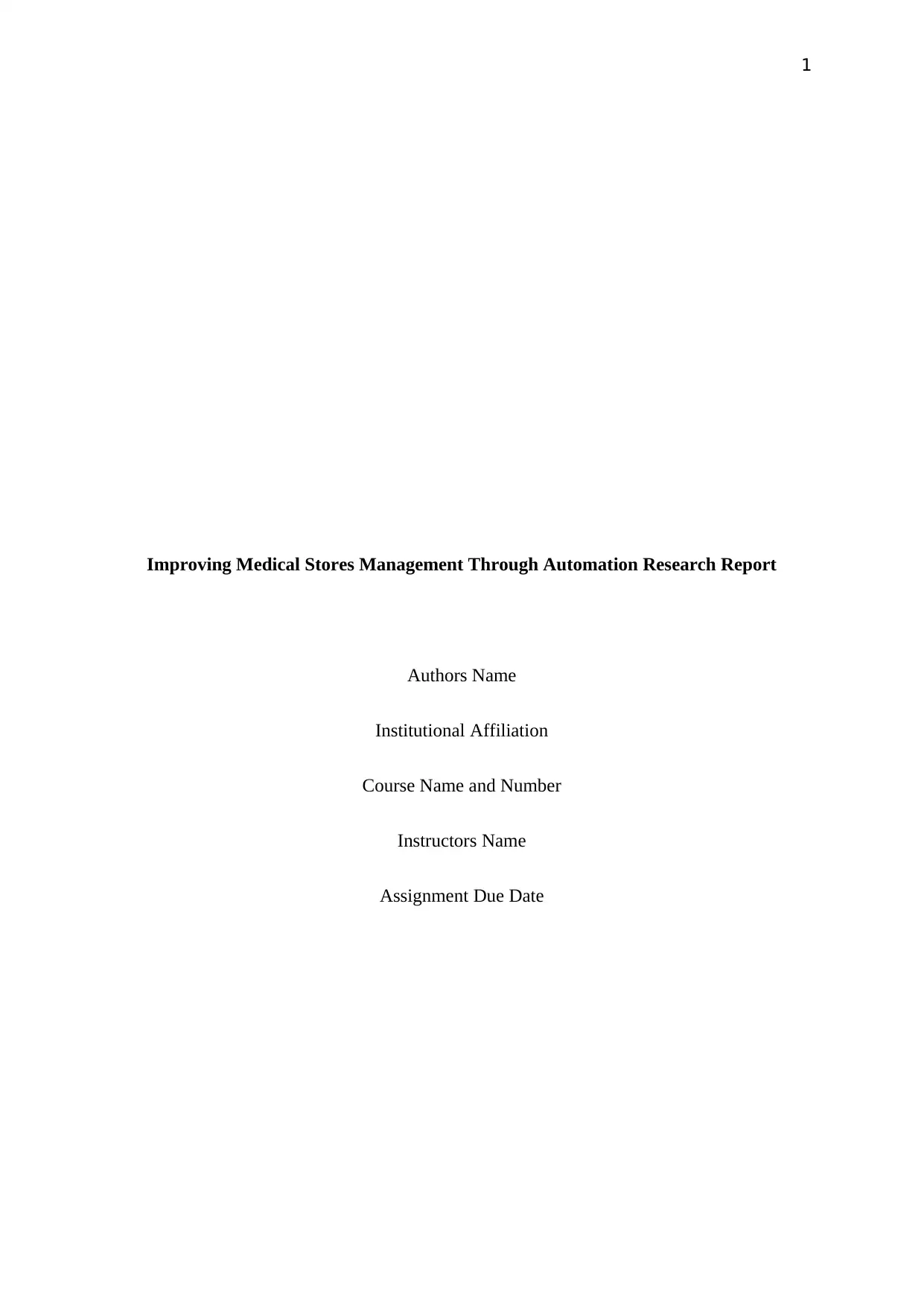
1
Improving Medical Stores Management Through Automation Research Report
Authors Name
Institutional Affiliation
Course Name and Number
Instructors Name
Assignment Due Date
Improving Medical Stores Management Through Automation Research Report
Authors Name
Institutional Affiliation
Course Name and Number
Instructors Name
Assignment Due Date
Secure Best Marks with AI Grader
Need help grading? Try our AI Grader for instant feedback on your assignments.
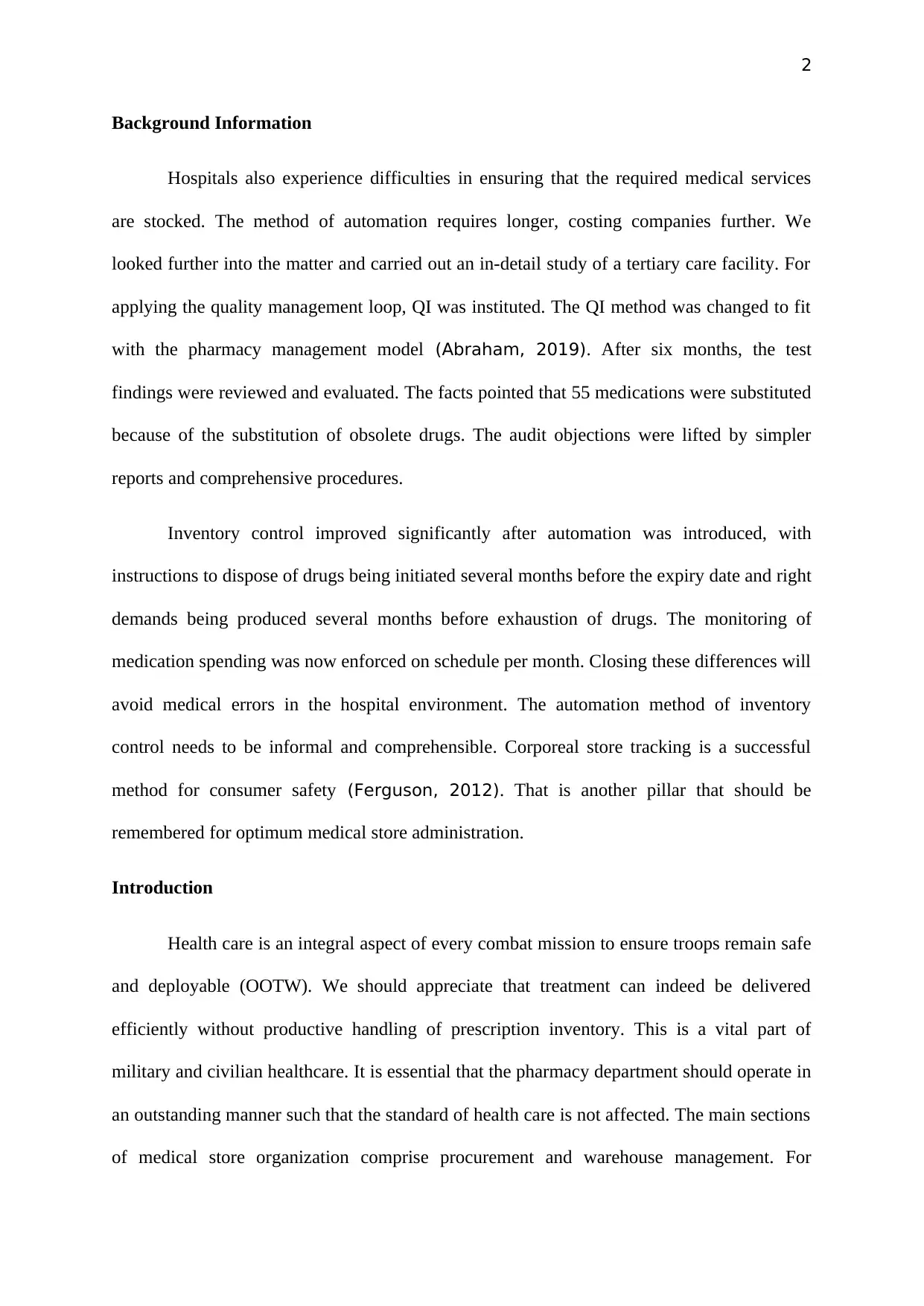
2
Background Information
Hospitals also experience difficulties in ensuring that the required medical services
are stocked. The method of automation requires longer, costing companies further. We
looked further into the matter and carried out an in-detail study of a tertiary care facility. For
applying the quality management loop, QI was instituted. The QI method was changed to fit
with the pharmacy management model (Abraham, 2019). After six months, the test
findings were reviewed and evaluated. The facts pointed that 55 medications were substituted
because of the substitution of obsolete drugs. The audit objections were lifted by simpler
reports and comprehensive procedures.
Inventory control improved significantly after automation was introduced, with
instructions to dispose of drugs being initiated several months before the expiry date and right
demands being produced several months before exhaustion of drugs. The monitoring of
medication spending was now enforced on schedule per month. Closing these differences will
avoid medical errors in the hospital environment. The automation method of inventory
control needs to be informal and comprehensible. Corporeal store tracking is a successful
method for consumer safety (Ferguson, 2012). That is another pillar that should be
remembered for optimum medical store administration.
Introduction
Health care is an integral aspect of every combat mission to ensure troops remain safe
and deployable (OOTW). We should appreciate that treatment can indeed be delivered
efficiently without productive handling of prescription inventory. This is a vital part of
military and civilian healthcare. It is essential that the pharmacy department should operate in
an outstanding manner such that the standard of health care is not affected. The main sections
of medical store organization comprise procurement and warehouse management. For
Background Information
Hospitals also experience difficulties in ensuring that the required medical services
are stocked. The method of automation requires longer, costing companies further. We
looked further into the matter and carried out an in-detail study of a tertiary care facility. For
applying the quality management loop, QI was instituted. The QI method was changed to fit
with the pharmacy management model (Abraham, 2019). After six months, the test
findings were reviewed and evaluated. The facts pointed that 55 medications were substituted
because of the substitution of obsolete drugs. The audit objections were lifted by simpler
reports and comprehensive procedures.
Inventory control improved significantly after automation was introduced, with
instructions to dispose of drugs being initiated several months before the expiry date and right
demands being produced several months before exhaustion of drugs. The monitoring of
medication spending was now enforced on schedule per month. Closing these differences will
avoid medical errors in the hospital environment. The automation method of inventory
control needs to be informal and comprehensible. Corporeal store tracking is a successful
method for consumer safety (Ferguson, 2012). That is another pillar that should be
remembered for optimum medical store administration.
Introduction
Health care is an integral aspect of every combat mission to ensure troops remain safe
and deployable (OOTW). We should appreciate that treatment can indeed be delivered
efficiently without productive handling of prescription inventory. This is a vital part of
military and civilian healthcare. It is essential that the pharmacy department should operate in
an outstanding manner such that the standard of health care is not affected. The main sections
of medical store organization comprise procurement and warehouse management. For
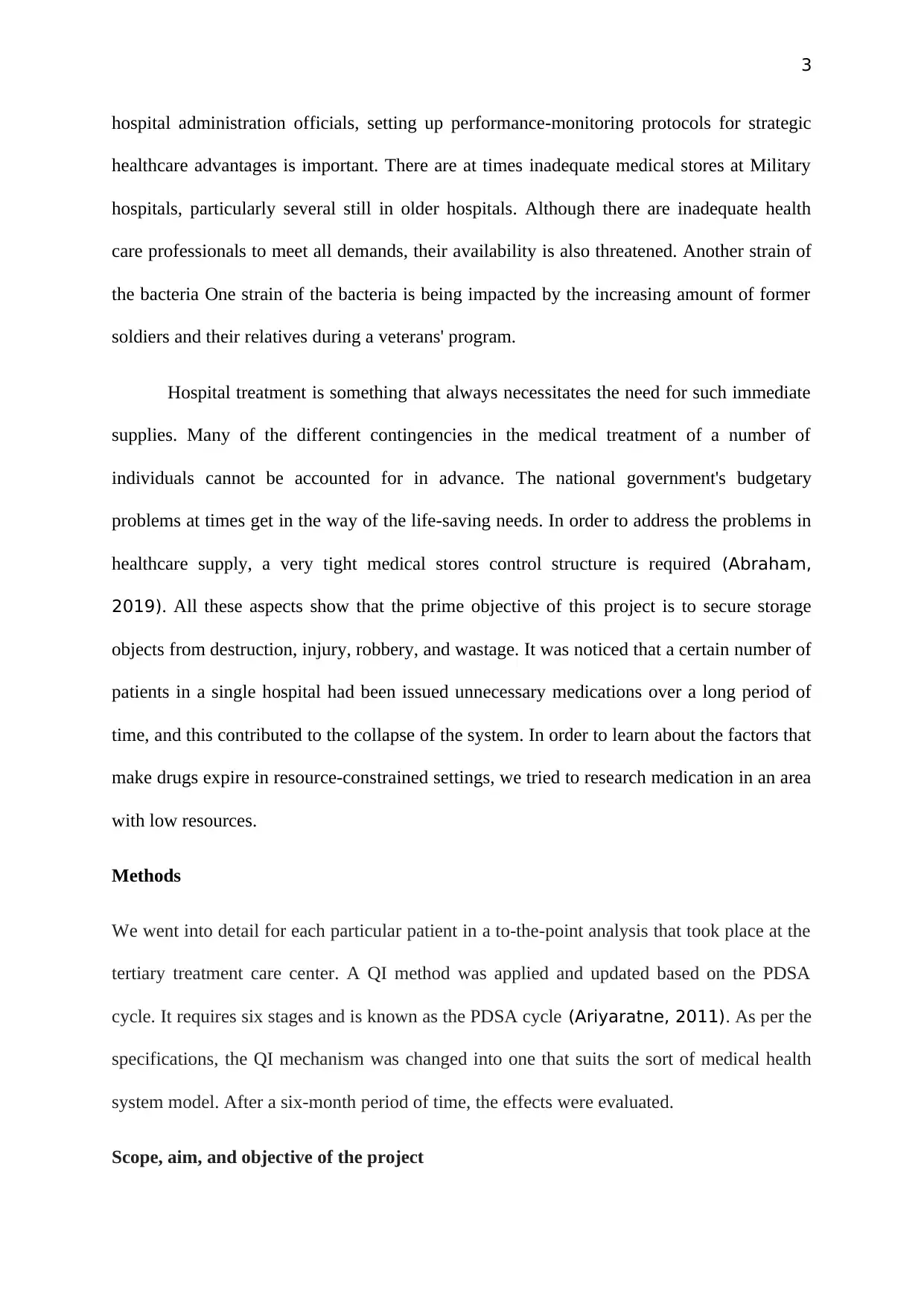
3
hospital administration officials, setting up performance-monitoring protocols for strategic
healthcare advantages is important. There are at times inadequate medical stores at Military
hospitals, particularly several still in older hospitals. Although there are inadequate health
care professionals to meet all demands, their availability is also threatened. Another strain of
the bacteria One strain of the bacteria is being impacted by the increasing amount of former
soldiers and their relatives during a veterans' program.
Hospital treatment is something that always necessitates the need for such immediate
supplies. Many of the different contingencies in the medical treatment of a number of
individuals cannot be accounted for in advance. The national government's budgetary
problems at times get in the way of the life-saving needs. In order to address the problems in
healthcare supply, a very tight medical stores control structure is required (Abraham,
2019). All these aspects show that the prime objective of this project is to secure storage
objects from destruction, injury, robbery, and wastage. It was noticed that a certain number of
patients in a single hospital had been issued unnecessary medications over a long period of
time, and this contributed to the collapse of the system. In order to learn about the factors that
make drugs expire in resource-constrained settings, we tried to research medication in an area
with low resources.
Methods
We went into detail for each particular patient in a to-the-point analysis that took place at the
tertiary treatment care center. A QI method was applied and updated based on the PDSA
cycle. It requires six stages and is known as the PDSA cycle (Ariyaratne, 2011). As per the
specifications, the QI mechanism was changed into one that suits the sort of medical health
system model. After a six-month period of time, the effects were evaluated.
Scope, aim, and objective of the project
hospital administration officials, setting up performance-monitoring protocols for strategic
healthcare advantages is important. There are at times inadequate medical stores at Military
hospitals, particularly several still in older hospitals. Although there are inadequate health
care professionals to meet all demands, their availability is also threatened. Another strain of
the bacteria One strain of the bacteria is being impacted by the increasing amount of former
soldiers and their relatives during a veterans' program.
Hospital treatment is something that always necessitates the need for such immediate
supplies. Many of the different contingencies in the medical treatment of a number of
individuals cannot be accounted for in advance. The national government's budgetary
problems at times get in the way of the life-saving needs. In order to address the problems in
healthcare supply, a very tight medical stores control structure is required (Abraham,
2019). All these aspects show that the prime objective of this project is to secure storage
objects from destruction, injury, robbery, and wastage. It was noticed that a certain number of
patients in a single hospital had been issued unnecessary medications over a long period of
time, and this contributed to the collapse of the system. In order to learn about the factors that
make drugs expire in resource-constrained settings, we tried to research medication in an area
with low resources.
Methods
We went into detail for each particular patient in a to-the-point analysis that took place at the
tertiary treatment care center. A QI method was applied and updated based on the PDSA
cycle. It requires six stages and is known as the PDSA cycle (Ariyaratne, 2011). As per the
specifications, the QI mechanism was changed into one that suits the sort of medical health
system model. After a six-month period of time, the effects were evaluated.
Scope, aim, and objective of the project
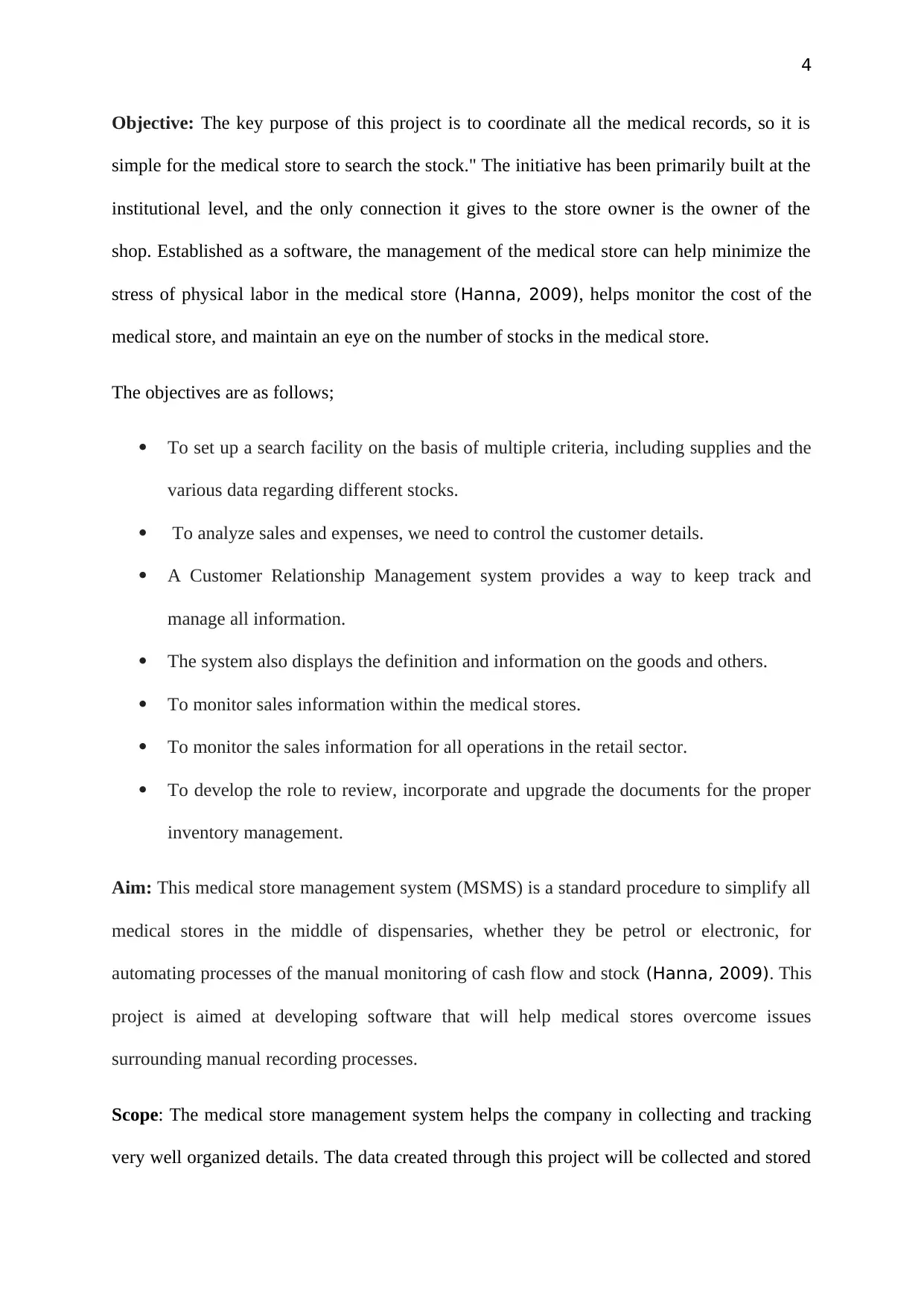
4
Objective: The key purpose of this project is to coordinate all the medical records, so it is
simple for the medical store to search the stock." The initiative has been primarily built at the
institutional level, and the only connection it gives to the store owner is the owner of the
shop. Established as a software, the management of the medical store can help minimize the
stress of physical labor in the medical store (Hanna, 2009), helps monitor the cost of the
medical store, and maintain an eye on the number of stocks in the medical store.
The objectives are as follows;
To set up a search facility on the basis of multiple criteria, including supplies and the
various data regarding different stocks.
To analyze sales and expenses, we need to control the customer details.
A Customer Relationship Management system provides a way to keep track and
manage all information.
The system also displays the definition and information on the goods and others.
To monitor sales information within the medical stores.
To monitor the sales information for all operations in the retail sector.
To develop the role to review, incorporate and upgrade the documents for the proper
inventory management.
Aim: This medical store management system (MSMS) is a standard procedure to simplify all
medical stores in the middle of dispensaries, whether they be petrol or electronic, for
automating processes of the manual monitoring of cash flow and stock (Hanna, 2009). This
project is aimed at developing software that will help medical stores overcome issues
surrounding manual recording processes.
Scope: The medical store management system helps the company in collecting and tracking
very well organized details. The data created through this project will be collected and stored
Objective: The key purpose of this project is to coordinate all the medical records, so it is
simple for the medical store to search the stock." The initiative has been primarily built at the
institutional level, and the only connection it gives to the store owner is the owner of the
shop. Established as a software, the management of the medical store can help minimize the
stress of physical labor in the medical store (Hanna, 2009), helps monitor the cost of the
medical store, and maintain an eye on the number of stocks in the medical store.
The objectives are as follows;
To set up a search facility on the basis of multiple criteria, including supplies and the
various data regarding different stocks.
To analyze sales and expenses, we need to control the customer details.
A Customer Relationship Management system provides a way to keep track and
manage all information.
The system also displays the definition and information on the goods and others.
To monitor sales information within the medical stores.
To monitor the sales information for all operations in the retail sector.
To develop the role to review, incorporate and upgrade the documents for the proper
inventory management.
Aim: This medical store management system (MSMS) is a standard procedure to simplify all
medical stores in the middle of dispensaries, whether they be petrol or electronic, for
automating processes of the manual monitoring of cash flow and stock (Hanna, 2009). This
project is aimed at developing software that will help medical stores overcome issues
surrounding manual recording processes.
Scope: The medical store management system helps the company in collecting and tracking
very well organized details. The data created through this project will be collected and stored
Secure Best Marks with AI Grader
Need help grading? Try our AI Grader for instant feedback on your assignments.
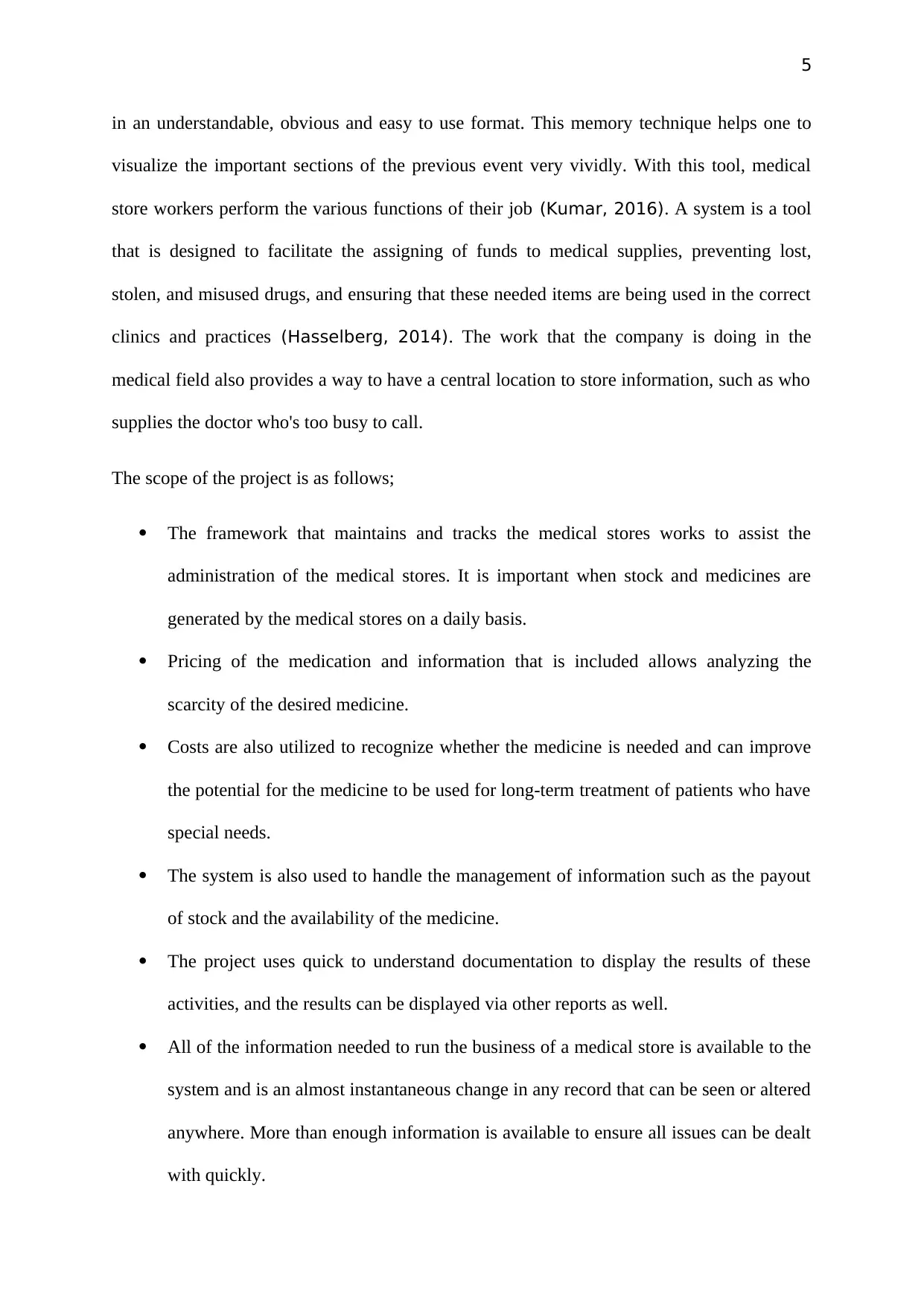
5
in an understandable, obvious and easy to use format. This memory technique helps one to
visualize the important sections of the previous event very vividly. With this tool, medical
store workers perform the various functions of their job (Kumar, 2016). A system is a tool
that is designed to facilitate the assigning of funds to medical supplies, preventing lost,
stolen, and misused drugs, and ensuring that these needed items are being used in the correct
clinics and practices (Hasselberg, 2014). The work that the company is doing in the
medical field also provides a way to have a central location to store information, such as who
supplies the doctor who's too busy to call.
The scope of the project is as follows;
The framework that maintains and tracks the medical stores works to assist the
administration of the medical stores. It is important when stock and medicines are
generated by the medical stores on a daily basis.
Pricing of the medication and information that is included allows analyzing the
scarcity of the desired medicine.
Costs are also utilized to recognize whether the medicine is needed and can improve
the potential for the medicine to be used for long-term treatment of patients who have
special needs.
The system is also used to handle the management of information such as the payout
of stock and the availability of the medicine.
The project uses quick to understand documentation to display the results of these
activities, and the results can be displayed via other reports as well.
All of the information needed to run the business of a medical store is available to the
system and is an almost instantaneous change in any record that can be seen or altered
anywhere. More than enough information is available to ensure all issues can be dealt
with quickly.
in an understandable, obvious and easy to use format. This memory technique helps one to
visualize the important sections of the previous event very vividly. With this tool, medical
store workers perform the various functions of their job (Kumar, 2016). A system is a tool
that is designed to facilitate the assigning of funds to medical supplies, preventing lost,
stolen, and misused drugs, and ensuring that these needed items are being used in the correct
clinics and practices (Hasselberg, 2014). The work that the company is doing in the
medical field also provides a way to have a central location to store information, such as who
supplies the doctor who's too busy to call.
The scope of the project is as follows;
The framework that maintains and tracks the medical stores works to assist the
administration of the medical stores. It is important when stock and medicines are
generated by the medical stores on a daily basis.
Pricing of the medication and information that is included allows analyzing the
scarcity of the desired medicine.
Costs are also utilized to recognize whether the medicine is needed and can improve
the potential for the medicine to be used for long-term treatment of patients who have
special needs.
The system is also used to handle the management of information such as the payout
of stock and the availability of the medicine.
The project uses quick to understand documentation to display the results of these
activities, and the results can be displayed via other reports as well.
All of the information needed to run the business of a medical store is available to the
system and is an almost instantaneous change in any record that can be seen or altered
anywhere. More than enough information is available to ensure all issues can be dealt
with quickly.
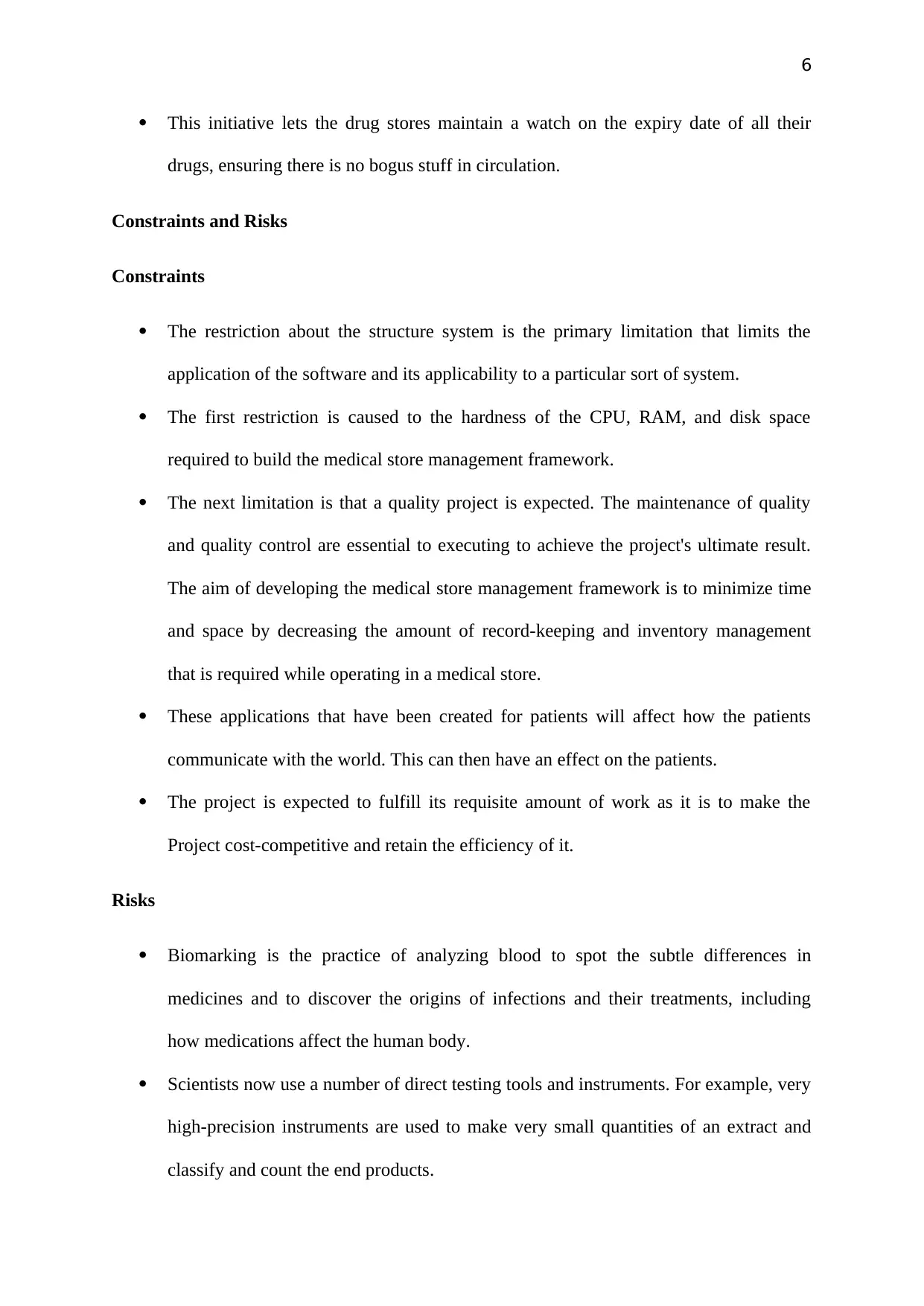
6
This initiative lets the drug stores maintain a watch on the expiry date of all their
drugs, ensuring there is no bogus stuff in circulation.
Constraints and Risks
Constraints
The restriction about the structure system is the primary limitation that limits the
application of the software and its applicability to a particular sort of system.
The first restriction is caused to the hardness of the CPU, RAM, and disk space
required to build the medical store management framework.
The next limitation is that a quality project is expected. The maintenance of quality
and quality control are essential to executing to achieve the project's ultimate result.
The aim of developing the medical store management framework is to minimize time
and space by decreasing the amount of record-keeping and inventory management
that is required while operating in a medical store.
These applications that have been created for patients will affect how the patients
communicate with the world. This can then have an effect on the patients.
The project is expected to fulfill its requisite amount of work as it is to make the
Project cost-competitive and retain the efficiency of it.
Risks
Biomarking is the practice of analyzing blood to spot the subtle differences in
medicines and to discover the origins of infections and their treatments, including
how medications affect the human body.
Scientists now use a number of direct testing tools and instruments. For example, very
high-precision instruments are used to make very small quantities of an extract and
classify and count the end products.
This initiative lets the drug stores maintain a watch on the expiry date of all their
drugs, ensuring there is no bogus stuff in circulation.
Constraints and Risks
Constraints
The restriction about the structure system is the primary limitation that limits the
application of the software and its applicability to a particular sort of system.
The first restriction is caused to the hardness of the CPU, RAM, and disk space
required to build the medical store management framework.
The next limitation is that a quality project is expected. The maintenance of quality
and quality control are essential to executing to achieve the project's ultimate result.
The aim of developing the medical store management framework is to minimize time
and space by decreasing the amount of record-keeping and inventory management
that is required while operating in a medical store.
These applications that have been created for patients will affect how the patients
communicate with the world. This can then have an effect on the patients.
The project is expected to fulfill its requisite amount of work as it is to make the
Project cost-competitive and retain the efficiency of it.
Risks
Biomarking is the practice of analyzing blood to spot the subtle differences in
medicines and to discover the origins of infections and their treatments, including
how medications affect the human body.
Scientists now use a number of direct testing tools and instruments. For example, very
high-precision instruments are used to make very small quantities of an extract and
classify and count the end products.
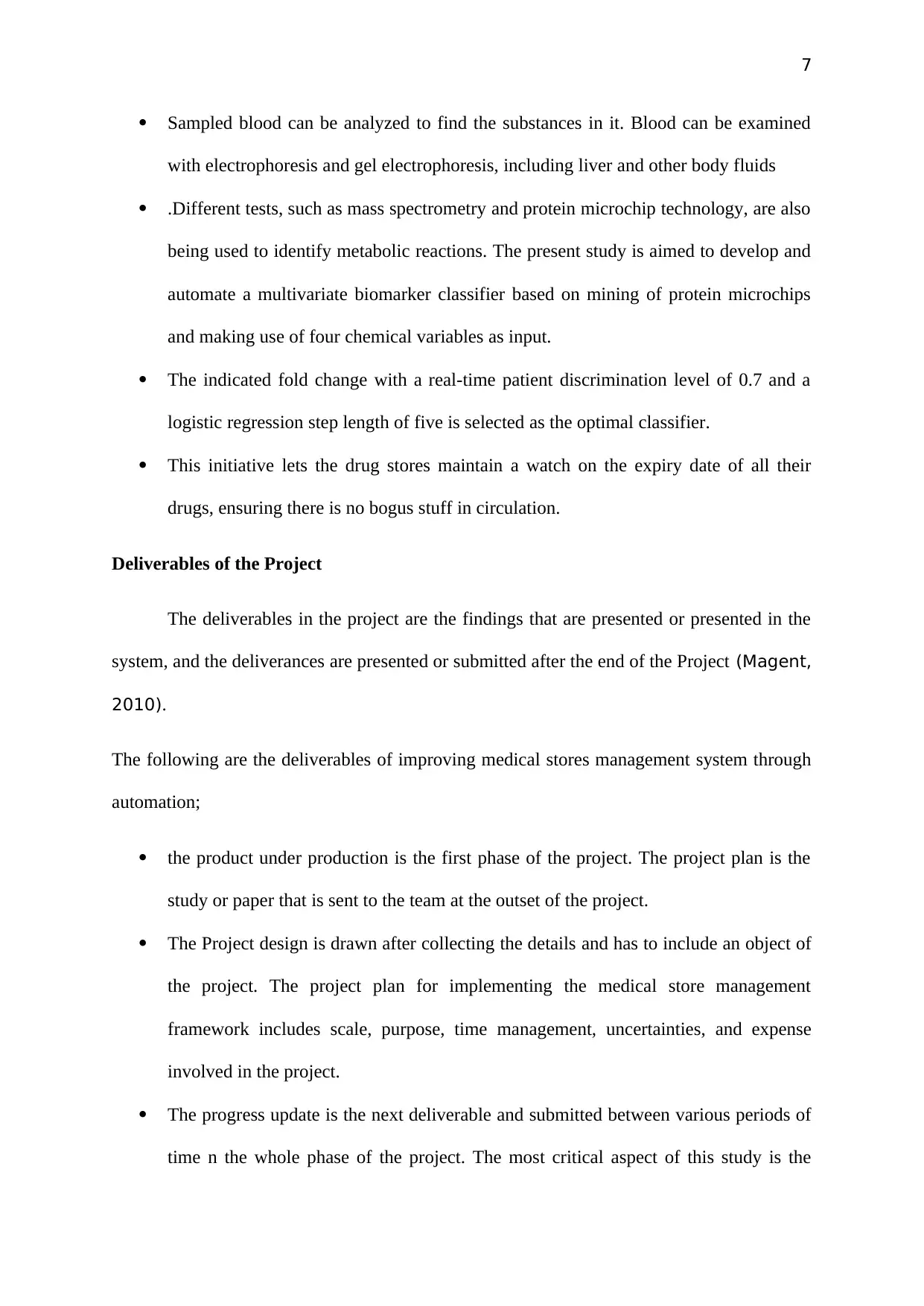
7
Sampled blood can be analyzed to find the substances in it. Blood can be examined
with electrophoresis and gel electrophoresis, including liver and other body fluids
.Different tests, such as mass spectrometry and protein microchip technology, are also
being used to identify metabolic reactions. The present study is aimed to develop and
automate a multivariate biomarker classifier based on mining of protein microchips
and making use of four chemical variables as input.
The indicated fold change with a real-time patient discrimination level of 0.7 and a
logistic regression step length of five is selected as the optimal classifier.
This initiative lets the drug stores maintain a watch on the expiry date of all their
drugs, ensuring there is no bogus stuff in circulation.
Deliverables of the Project
The deliverables in the project are the findings that are presented or presented in the
system, and the deliverances are presented or submitted after the end of the Project (Magent,
2010).
The following are the deliverables of improving medical stores management system through
automation;
the product under production is the first phase of the project. The project plan is the
study or paper that is sent to the team at the outset of the project.
The Project design is drawn after collecting the details and has to include an object of
the project. The project plan for implementing the medical store management
framework includes scale, purpose, time management, uncertainties, and expense
involved in the project.
The progress update is the next deliverable and submitted between various periods of
time n the whole phase of the project. The most critical aspect of this study is the
Sampled blood can be analyzed to find the substances in it. Blood can be examined
with electrophoresis and gel electrophoresis, including liver and other body fluids
.Different tests, such as mass spectrometry and protein microchip technology, are also
being used to identify metabolic reactions. The present study is aimed to develop and
automate a multivariate biomarker classifier based on mining of protein microchips
and making use of four chemical variables as input.
The indicated fold change with a real-time patient discrimination level of 0.7 and a
logistic regression step length of five is selected as the optimal classifier.
This initiative lets the drug stores maintain a watch on the expiry date of all their
drugs, ensuring there is no bogus stuff in circulation.
Deliverables of the Project
The deliverables in the project are the findings that are presented or presented in the
system, and the deliverances are presented or submitted after the end of the Project (Magent,
2010).
The following are the deliverables of improving medical stores management system through
automation;
the product under production is the first phase of the project. The project plan is the
study or paper that is sent to the team at the outset of the project.
The Project design is drawn after collecting the details and has to include an object of
the project. The project plan for implementing the medical store management
framework includes scale, purpose, time management, uncertainties, and expense
involved in the project.
The progress update is the next deliverable and submitted between various periods of
time n the whole phase of the project. The most critical aspect of this study is the
Paraphrase This Document
Need a fresh take? Get an instant paraphrase of this document with our AI Paraphraser
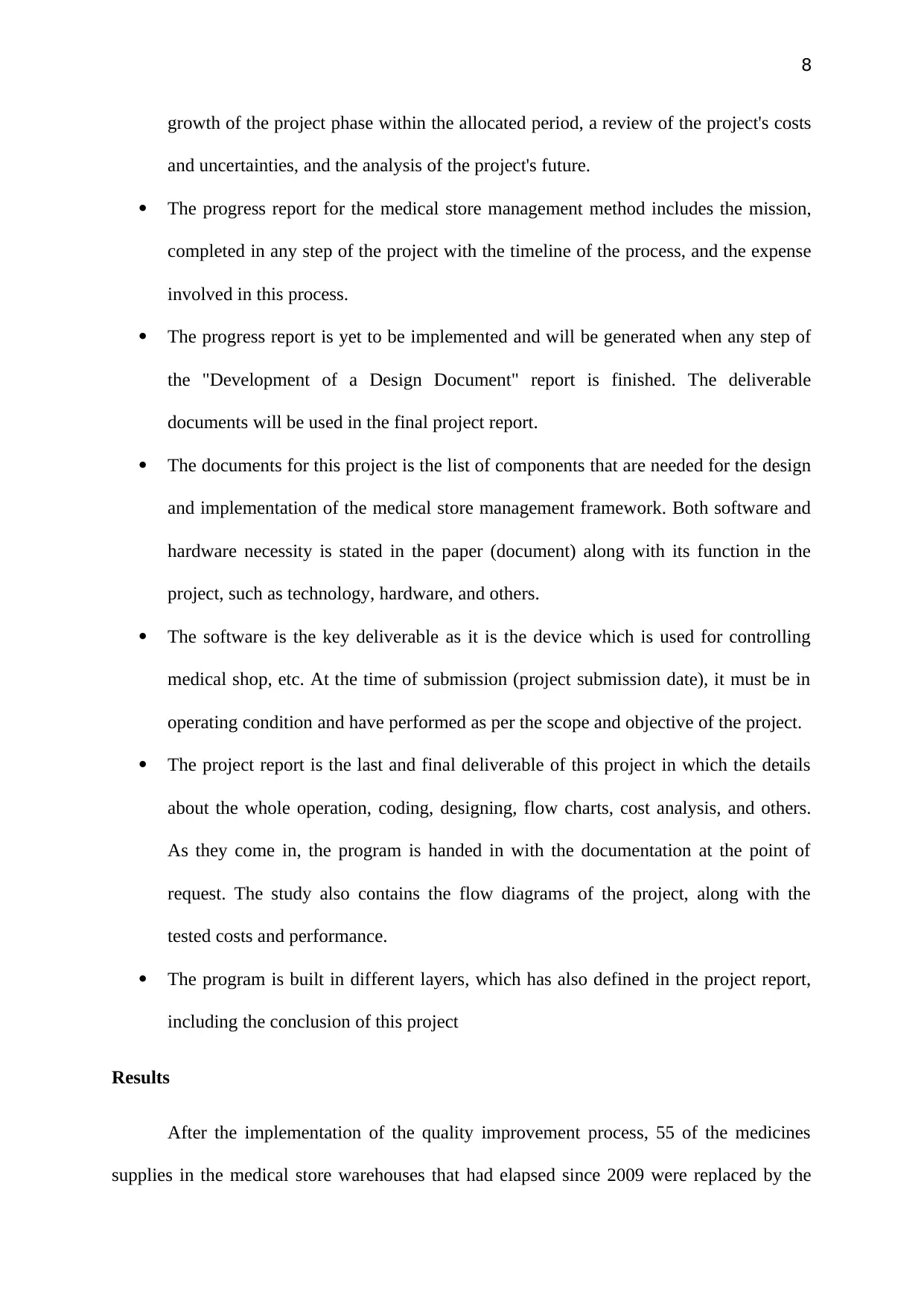
8
growth of the project phase within the allocated period, a review of the project's costs
and uncertainties, and the analysis of the project's future.
The progress report for the medical store management method includes the mission,
completed in any step of the project with the timeline of the process, and the expense
involved in this process.
The progress report is yet to be implemented and will be generated when any step of
the "Development of a Design Document" report is finished. The deliverable
documents will be used in the final project report.
The documents for this project is the list of components that are needed for the design
and implementation of the medical store management framework. Both software and
hardware necessity is stated in the paper (document) along with its function in the
project, such as technology, hardware, and others.
The software is the key deliverable as it is the device which is used for controlling
medical shop, etc. At the time of submission (project submission date), it must be in
operating condition and have performed as per the scope and objective of the project.
The project report is the last and final deliverable of this project in which the details
about the whole operation, coding, designing, flow charts, cost analysis, and others.
As they come in, the program is handed in with the documentation at the point of
request. The study also contains the flow diagrams of the project, along with the
tested costs and performance.
The program is built in different layers, which has also defined in the project report,
including the conclusion of this project
Results
After the implementation of the quality improvement process, 55 of the medicines
supplies in the medical store warehouses that had elapsed since 2009 were replaced by the
growth of the project phase within the allocated period, a review of the project's costs
and uncertainties, and the analysis of the project's future.
The progress report for the medical store management method includes the mission,
completed in any step of the project with the timeline of the process, and the expense
involved in this process.
The progress report is yet to be implemented and will be generated when any step of
the "Development of a Design Document" report is finished. The deliverable
documents will be used in the final project report.
The documents for this project is the list of components that are needed for the design
and implementation of the medical store management framework. Both software and
hardware necessity is stated in the paper (document) along with its function in the
project, such as technology, hardware, and others.
The software is the key deliverable as it is the device which is used for controlling
medical shop, etc. At the time of submission (project submission date), it must be in
operating condition and have performed as per the scope and objective of the project.
The project report is the last and final deliverable of this project in which the details
about the whole operation, coding, designing, flow charts, cost analysis, and others.
As they come in, the program is handed in with the documentation at the point of
request. The study also contains the flow diagrams of the project, along with the
tested costs and performance.
The program is built in different layers, which has also defined in the project report,
including the conclusion of this project
Results
After the implementation of the quality improvement process, 55 of the medicines
supplies in the medical store warehouses that had elapsed since 2009 were replaced by the
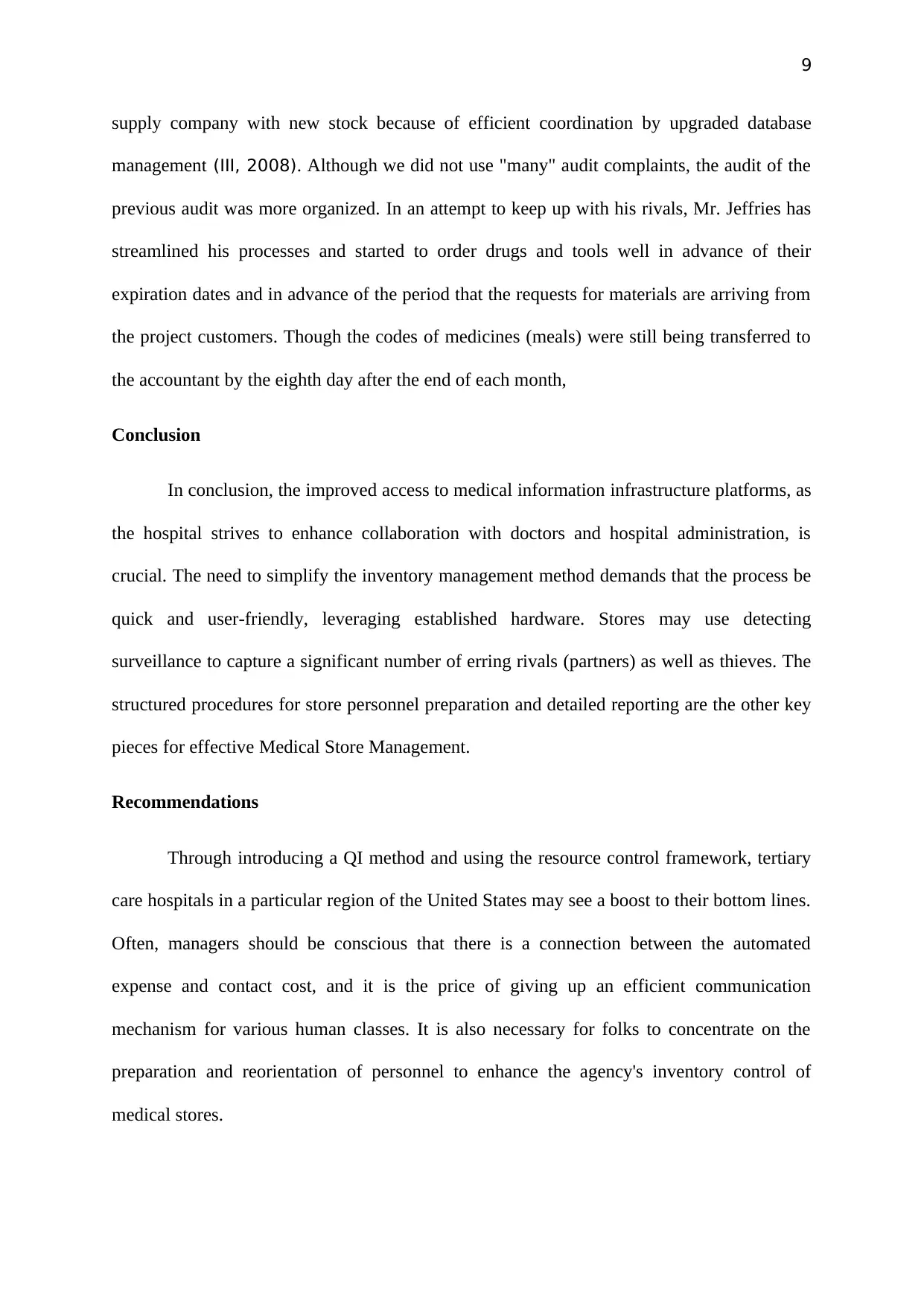
9
supply company with new stock because of efficient coordination by upgraded database
management (III, 2008). Although we did not use "many" audit complaints, the audit of the
previous audit was more organized. In an attempt to keep up with his rivals, Mr. Jeffries has
streamlined his processes and started to order drugs and tools well in advance of their
expiration dates and in advance of the period that the requests for materials are arriving from
the project customers. Though the codes of medicines (meals) were still being transferred to
the accountant by the eighth day after the end of each month,
Conclusion
In conclusion, the improved access to medical information infrastructure platforms, as
the hospital strives to enhance collaboration with doctors and hospital administration, is
crucial. The need to simplify the inventory management method demands that the process be
quick and user-friendly, leveraging established hardware. Stores may use detecting
surveillance to capture a significant number of erring rivals (partners) as well as thieves. The
structured procedures for store personnel preparation and detailed reporting are the other key
pieces for effective Medical Store Management.
Recommendations
Through introducing a QI method and using the resource control framework, tertiary
care hospitals in a particular region of the United States may see a boost to their bottom lines.
Often, managers should be conscious that there is a connection between the automated
expense and contact cost, and it is the price of giving up an efficient communication
mechanism for various human classes. It is also necessary for folks to concentrate on the
preparation and reorientation of personnel to enhance the agency's inventory control of
medical stores.
supply company with new stock because of efficient coordination by upgraded database
management (III, 2008). Although we did not use "many" audit complaints, the audit of the
previous audit was more organized. In an attempt to keep up with his rivals, Mr. Jeffries has
streamlined his processes and started to order drugs and tools well in advance of their
expiration dates and in advance of the period that the requests for materials are arriving from
the project customers. Though the codes of medicines (meals) were still being transferred to
the accountant by the eighth day after the end of each month,
Conclusion
In conclusion, the improved access to medical information infrastructure platforms, as
the hospital strives to enhance collaboration with doctors and hospital administration, is
crucial. The need to simplify the inventory management method demands that the process be
quick and user-friendly, leveraging established hardware. Stores may use detecting
surveillance to capture a significant number of erring rivals (partners) as well as thieves. The
structured procedures for store personnel preparation and detailed reporting are the other key
pieces for effective Medical Store Management.
Recommendations
Through introducing a QI method and using the resource control framework, tertiary
care hospitals in a particular region of the United States may see a boost to their bottom lines.
Often, managers should be conscious that there is a connection between the automated
expense and contact cost, and it is the price of giving up an efficient communication
mechanism for various human classes. It is also necessary for folks to concentrate on the
preparation and reorientation of personnel to enhance the agency's inventory control of
medical stores.
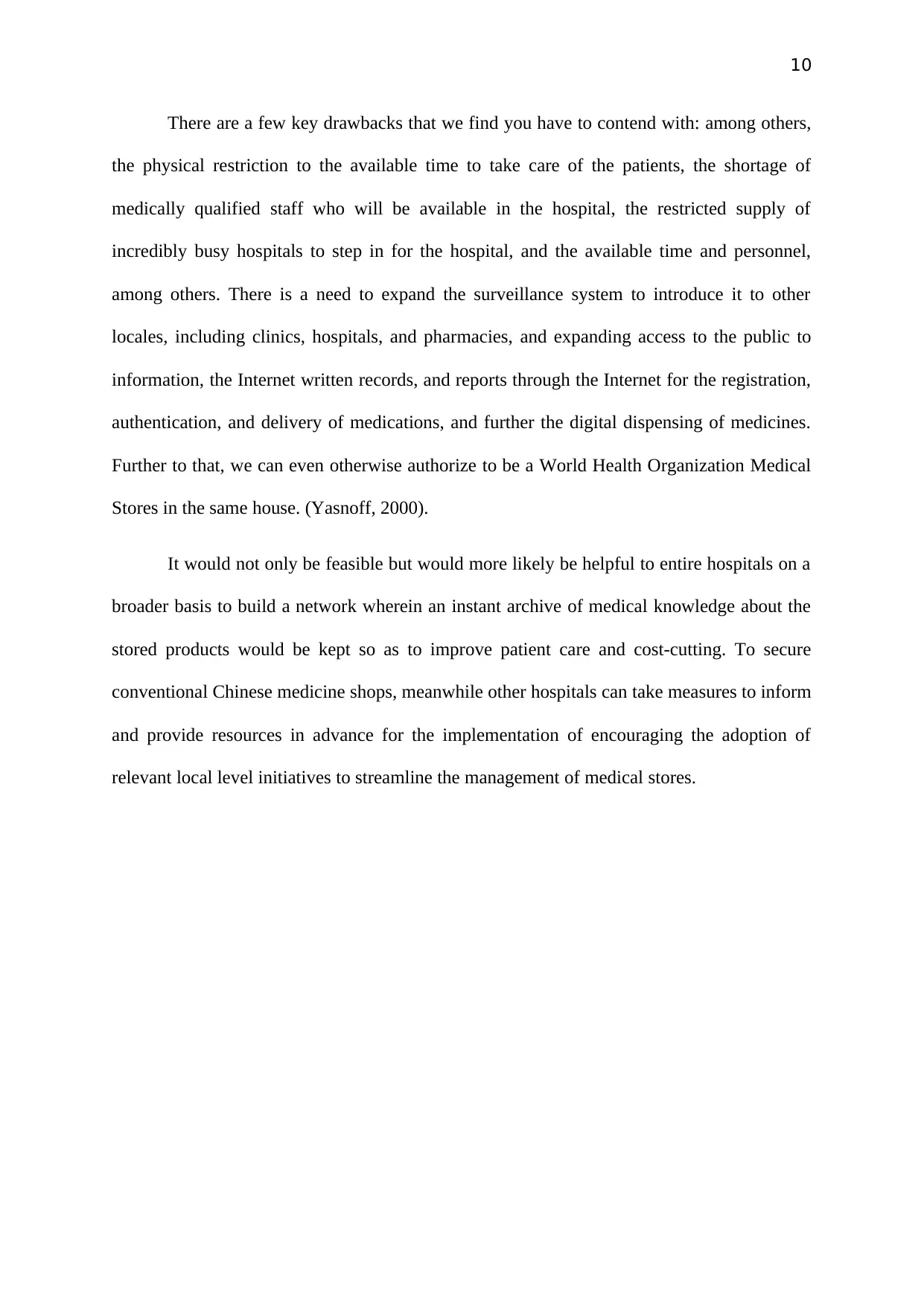
10
There are a few key drawbacks that we find you have to contend with: among others,
the physical restriction to the available time to take care of the patients, the shortage of
medically qualified staff who will be available in the hospital, the restricted supply of
incredibly busy hospitals to step in for the hospital, and the available time and personnel,
among others. There is a need to expand the surveillance system to introduce it to other
locales, including clinics, hospitals, and pharmacies, and expanding access to the public to
information, the Internet written records, and reports through the Internet for the registration,
authentication, and delivery of medications, and further the digital dispensing of medicines.
Further to that, we can even otherwise authorize to be a World Health Organization Medical
Stores in the same house. (Yasnoff, 2000).
It would not only be feasible but would more likely be helpful to entire hospitals on a
broader basis to build a network wherein an instant archive of medical knowledge about the
stored products would be kept so as to improve patient care and cost-cutting. To secure
conventional Chinese medicine shops, meanwhile other hospitals can take measures to inform
and provide resources in advance for the implementation of encouraging the adoption of
relevant local level initiatives to streamline the management of medical stores.
There are a few key drawbacks that we find you have to contend with: among others,
the physical restriction to the available time to take care of the patients, the shortage of
medically qualified staff who will be available in the hospital, the restricted supply of
incredibly busy hospitals to step in for the hospital, and the available time and personnel,
among others. There is a need to expand the surveillance system to introduce it to other
locales, including clinics, hospitals, and pharmacies, and expanding access to the public to
information, the Internet written records, and reports through the Internet for the registration,
authentication, and delivery of medications, and further the digital dispensing of medicines.
Further to that, we can even otherwise authorize to be a World Health Organization Medical
Stores in the same house. (Yasnoff, 2000).
It would not only be feasible but would more likely be helpful to entire hospitals on a
broader basis to build a network wherein an instant archive of medical knowledge about the
stored products would be kept so as to improve patient care and cost-cutting. To secure
conventional Chinese medicine shops, meanwhile other hospitals can take measures to inform
and provide resources in advance for the implementation of encouraging the adoption of
relevant local level initiatives to streamline the management of medical stores.
Secure Best Marks with AI Grader
Need help grading? Try our AI Grader for instant feedback on your assignments.
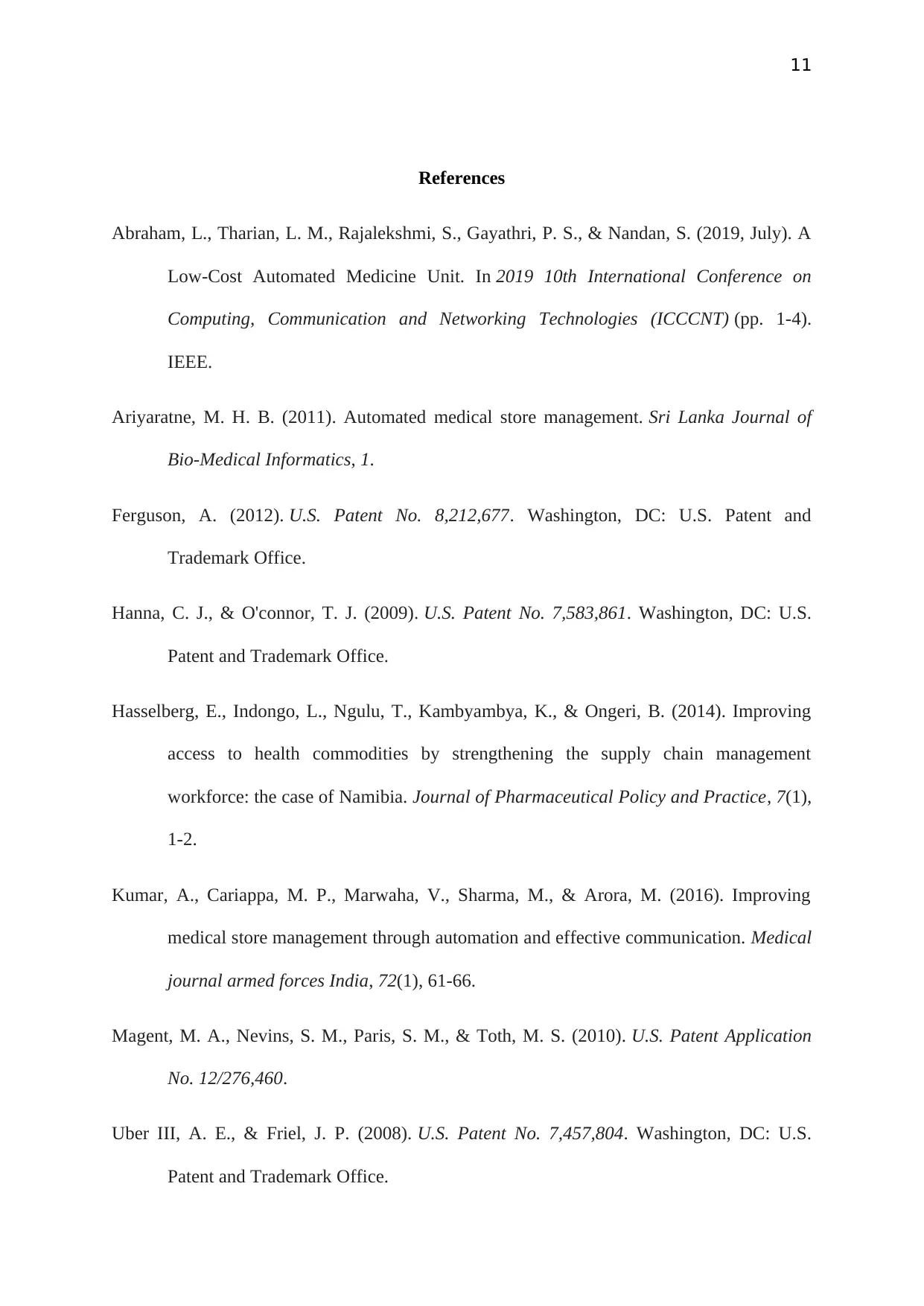
11
References
Abraham, L., Tharian, L. M., Rajalekshmi, S., Gayathri, P. S., & Nandan, S. (2019, July). A
Low-Cost Automated Medicine Unit. In 2019 10th International Conference on
Computing, Communication and Networking Technologies (ICCCNT) (pp. 1-4).
IEEE.
Ariyaratne, M. H. B. (2011). Automated medical store management. Sri Lanka Journal of
Bio-Medical Informatics, 1.
Ferguson, A. (2012). U.S. Patent No. 8,212,677. Washington, DC: U.S. Patent and
Trademark Office.
Hanna, C. J., & O'connor, T. J. (2009). U.S. Patent No. 7,583,861. Washington, DC: U.S.
Patent and Trademark Office.
Hasselberg, E., Indongo, L., Ngulu, T., Kambyambya, K., & Ongeri, B. (2014). Improving
access to health commodities by strengthening the supply chain management
workforce: the case of Namibia. Journal of Pharmaceutical Policy and Practice, 7(1),
1-2.
Kumar, A., Cariappa, M. P., Marwaha, V., Sharma, M., & Arora, M. (2016). Improving
medical store management through automation and effective communication. Medical
journal armed forces India, 72(1), 61-66.
Magent, M. A., Nevins, S. M., Paris, S. M., & Toth, M. S. (2010). U.S. Patent Application
No. 12/276,460.
Uber III, A. E., & Friel, J. P. (2008). U.S. Patent No. 7,457,804. Washington, DC: U.S.
Patent and Trademark Office.
References
Abraham, L., Tharian, L. M., Rajalekshmi, S., Gayathri, P. S., & Nandan, S. (2019, July). A
Low-Cost Automated Medicine Unit. In 2019 10th International Conference on
Computing, Communication and Networking Technologies (ICCCNT) (pp. 1-4).
IEEE.
Ariyaratne, M. H. B. (2011). Automated medical store management. Sri Lanka Journal of
Bio-Medical Informatics, 1.
Ferguson, A. (2012). U.S. Patent No. 8,212,677. Washington, DC: U.S. Patent and
Trademark Office.
Hanna, C. J., & O'connor, T. J. (2009). U.S. Patent No. 7,583,861. Washington, DC: U.S.
Patent and Trademark Office.
Hasselberg, E., Indongo, L., Ngulu, T., Kambyambya, K., & Ongeri, B. (2014). Improving
access to health commodities by strengthening the supply chain management
workforce: the case of Namibia. Journal of Pharmaceutical Policy and Practice, 7(1),
1-2.
Kumar, A., Cariappa, M. P., Marwaha, V., Sharma, M., & Arora, M. (2016). Improving
medical store management through automation and effective communication. Medical
journal armed forces India, 72(1), 61-66.
Magent, M. A., Nevins, S. M., Paris, S. M., & Toth, M. S. (2010). U.S. Patent Application
No. 12/276,460.
Uber III, A. E., & Friel, J. P. (2008). U.S. Patent No. 7,457,804. Washington, DC: U.S.
Patent and Trademark Office.
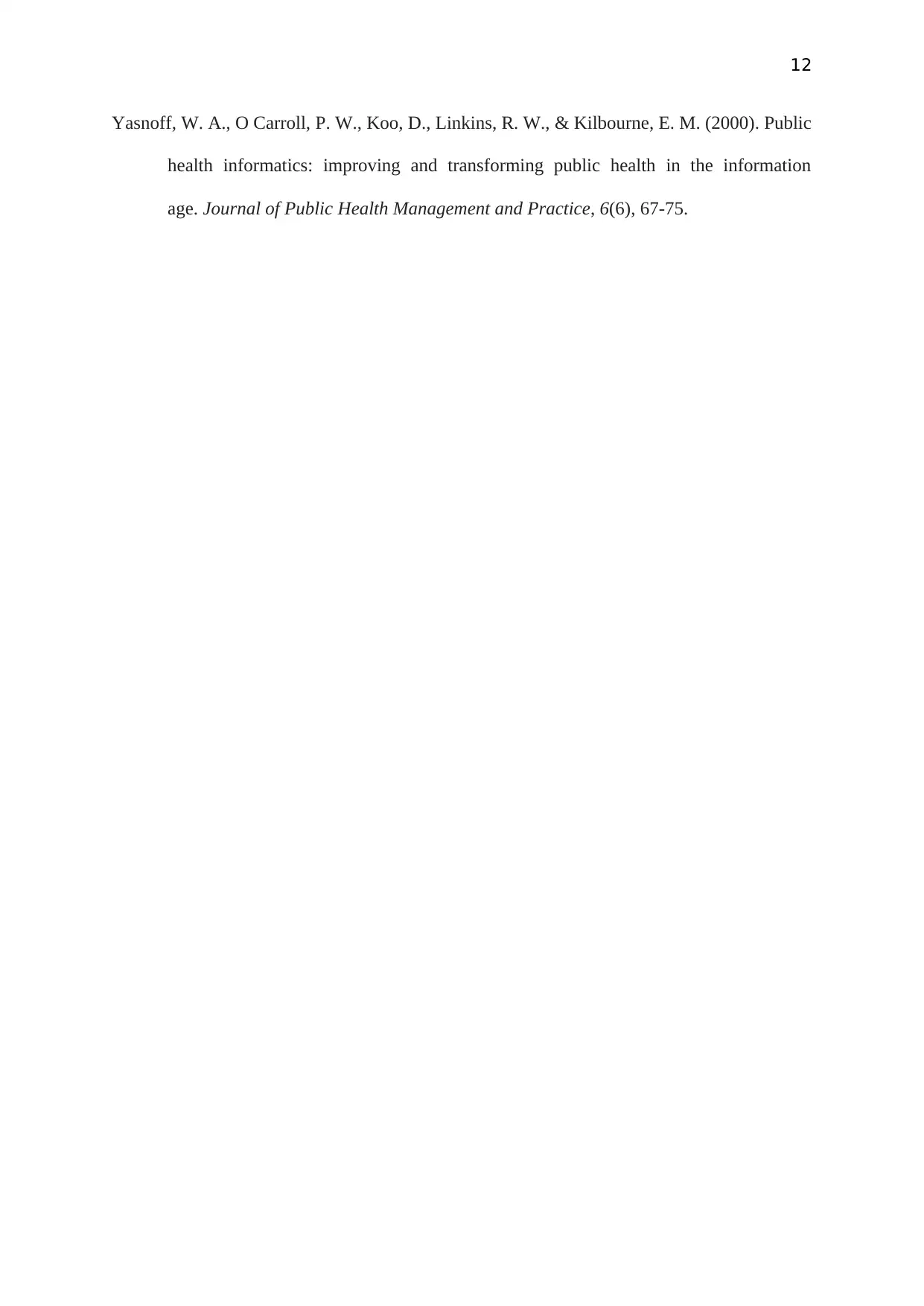
12
Yasnoff, W. A., O Carroll, P. W., Koo, D., Linkins, R. W., & Kilbourne, E. M. (2000). Public
health informatics: improving and transforming public health in the information
age. Journal of Public Health Management and Practice, 6(6), 67-75.
Yasnoff, W. A., O Carroll, P. W., Koo, D., Linkins, R. W., & Kilbourne, E. M. (2000). Public
health informatics: improving and transforming public health in the information
age. Journal of Public Health Management and Practice, 6(6), 67-75.
1 out of 12
Related Documents
Your All-in-One AI-Powered Toolkit for Academic Success.
+13062052269
info@desklib.com
Available 24*7 on WhatsApp / Email
![[object Object]](/_next/static/media/star-bottom.7253800d.svg)
Unlock your academic potential
© 2024 | Zucol Services PVT LTD | All rights reserved.





